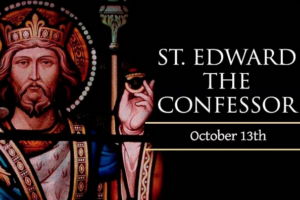St. Edward was born in 1003, the son of the Duke of Normandy and nephew of King Edmund Ironside of England.
Grew up in exile 
He grew up in exile in Normandy from the age of 10, when the Danes gained control of England. The early experience of loss, coupled with his earnest religious piety, caused him to renounce worldly ambition and devote himself to the love of God.
Called to be King of England
The Danish king, Canute, was also known as Cnut and Cnut the Great, and was King of England from 1016, King of Denmark from 1018, and King of Norway from 1028 until his death in 1035. The three kingdoms united under Cnut’s rule are referred to together as the North Sea Empire.
On the death of the Danish King, Canute, the rightful exiled heir, Edward, was called to the throne of England in 1042., which he accepted dutifully and held until 1066.
His saintly bearing made him a popular sovereign, and his actions even more so. He abolished an unjust tax and was known to cure people with his touch.
Having made a vow of chastity, King Edward accepted marriage for the sake of his kingdom, but lived with his queen in celibacy, as brother and sister. 
Unable to fulfill a vow to embark on a pilgrimage to Saint Peter’s tomb without leaving his subjects vulnerable to attack, his vow was commuted by the pope to the rebuilding of Saint Peter’s Abbey in Westminister, where he was buried upon his death a week after its dedication.
Edward died on January 5, 1066, and was canonized by Pope Alexander III in 1161.
RELATED RESOURCES:
Edward the Confessor (Penguin Monarchs): The Sainted King — By David Woodman — In this revealing portrait of England’s royal saint, David Woodman traces the course of Edward’s twenty-four-year-long reign through the lens of contemporary sources, from the Anglo-Saxon Chronicle and the Vita Ædwardi Regis to the Bayeux Tapestry…The twists and turns of Edward’s reign are generally seen as a prelude to the Norman Conquest in 1066. Woodman explains clearly how events unfolded and personalities interacted but, unlike many, he shows a capable and impressive king at the centre of them.
Edward the Confessor: Last of the Royal Blood (The English Monarchs Series) — By
- Edward the Confessor — by Frank Barlow — Frank Barlow’s magisterial biography, first published in 1970 and now reissued with new material, rescues Edward the Confessor from contemporary myth and subsequent bogus scholarship. Disentangling verifiable fact from saintly legend, he vividly re-creates the final years of the Anglo-Danish monarchy and examines England before the Norman Conquest with deep insight and great historical understanding.<
- Edward the Confessor: King of England — by Peter Rex — Edward the Confessor was the son of King Aethelred the Unready of the House of Wessex. The family was exiled to Normandy when the Danish invaded England in 1013 but, with the nation in crisis on the death of King Harthacnut twenty-nine years later, Edward was named King of England, restoring the throne to English rule. Often portrayed as a holy simpleton, Edward was in fact a wily and devious king. For most kings a childless marriage would have been an Achilles’ heel, but Edward turned it to his advantage…




You must be logged in to post a comment.